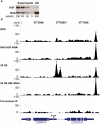Chromatin landscape dictates HSF binding to target DNA elements
- PMID: 20844575
- PMCID: PMC2936546
- DOI: 10.1371/journal.pgen.1001114
Chromatin landscape dictates HSF binding to target DNA elements
Abstract
Sequence-specific transcription factors (TFs) are critical for specifying patterns and levels of gene expression, but target DNA elements are not sufficient to specify TF binding in vivo. In eukaryotes, the binding of a TF is in competition with a constellation of other proteins, including histones, which package DNA into nucleosomes. We used the ChIP-seq assay to examine the genome-wide distribution of Drosophila Heat Shock Factor (HSF), a TF whose binding activity is mediated by heat shock-induced trimerization. HSF binds to 464 sites after heat shock, the vast majority of which contain HSF Sequence-binding Elements (HSEs). HSF-bound sequence motifs represent only a small fraction of the total HSEs present in the genome. ModENCODE ChIP-chip datasets, generated during non-heat shock conditions, were used to show that inducibly bound HSE motifs are associated with histone acetylation, H3K4 trimethylation, RNA Polymerase II, and coactivators, compared to HSE motifs that remain HSF-free. Furthermore, directly changing the chromatin landscape, from an inactive to an active state, permits inducible HSF binding. There is a strong correlation of bound HSEs to active chromatin marks present prior to induced HSF binding, indicating that an HSE's residence in "active" chromatin is a primary determinant of whether HSF can bind following heat shock.
Conflict of interest statement
The authors have declared that no competing interests exist.
Figures







Similar articles
-
Accurate prediction of inducible transcription factor binding intensities in vivo.PLoS Genet. 2012;8(3):e1002610. doi: 10.1371/journal.pgen.1002610. Epub 2012 Mar 29. PLoS Genet. 2012. PMID: 22479205 Free PMC article.
-
Cooperative binding of heat shock transcription factor to the Hsp70 promoter in vivo and in vitro.J Biol Chem. 1994 Feb 18;269(7):4804-11. J Biol Chem. 1994. PMID: 8106450
-
HSF access to heat shock elements in vivo depends critically on promoter architecture defined by GAGA factor, TFIID, and RNA polymerase II binding sites.Genes Dev. 1995 Nov 15;9(22):2756-69. doi: 10.1101/gad.9.22.2756. Genes Dev. 1995. PMID: 7590251
-
Whole-genome analysis reveals that active heat shock factor binding sites are mostly associated with non-heat shock genes in Drosophila melanogaster.PLoS One. 2011 Jan 14;6(1):e15934. doi: 10.1371/journal.pone.0015934. PLoS One. 2011. PMID: 21264254 Free PMC article.
-
Drosophila heat shock system as a general model to investigate transcriptional regulation.Cold Spring Harb Symp Quant Biol. 2010;75:1-9. doi: 10.1101/sqb.2010.75.039. Epub 2011 Apr 5. Cold Spring Harb Symp Quant Biol. 2010. PMID: 21467139 Free PMC article. Review.
Cited by
-
Modulating the Heat Stress Response to Improve Hyperthermia-Based Anticancer Treatments.Cancers (Basel). 2021 Mar 12;13(6):1243. doi: 10.3390/cancers13061243. Cancers (Basel). 2021. PMID: 33808973 Free PMC article. Review.
-
Heat shock factor 1 (HSF1) controls chemoresistance and autophagy through transcriptional regulation of autophagy-related protein 7 (ATG7).J Biol Chem. 2013 Mar 29;288(13):9165-76. doi: 10.1074/jbc.M112.422071. Epub 2013 Feb 5. J Biol Chem. 2013. PMID: 23386620 Free PMC article.
-
An improved auxin-inducible degron system preserves native protein levels and enables rapid and specific protein depletion.Genes Dev. 2019 Oct 1;33(19-20):1441-1455. doi: 10.1101/gad.328237.119. Epub 2019 Aug 29. Genes Dev. 2019. PMID: 31467088 Free PMC article.
-
Ethanol actions on the ventral tegmental area: novel potential targets on reward pathway neurons.Psychopharmacology (Berl). 2018 Jun;235(6):1711-1726. doi: 10.1007/s00213-018-4875-y. Epub 2018 Mar 16. Psychopharmacology (Berl). 2018. PMID: 29549390 Free PMC article. Review.
-
Distinct functional constraints partition sequence conservation in a cis-regulatory element.PLoS Genet. 2011 Jun;7(6):e1002095. doi: 10.1371/journal.pgen.1002095. Epub 2011 Jun 2. PLoS Genet. 2011. PMID: 21655084 Free PMC article.
References
-
- Wei CL, Wu Q, Vega VB, Chiu KP, Ng P, et al. A global map of p53 transcription-factor binding sites in the human genome. Cell. 2006;124:207–219. - PubMed
-
- Yang A, Zhu Z, Kapranov P, McKeon F, Church GM, et al. Relationships between p63 binding, DNA sequence, transcription activity, and biological function in human cells. Mol Cell. 2006;24:593–602. - PubMed
-
- Biggin MD, McGinnis W. Regulation of segmentation and segmental identity by Drosophila homeoproteins: The role of DNA binding in functional activity and specificity. Development. 1997;124:4425–4433. - PubMed
Publication types
MeSH terms
Substances
Grants and funding
LinkOut - more resources
Full Text Sources
Molecular Biology Databases
Miscellaneous

